The Microsoft Surface Book 3 (15-Inch) Review: A Refreshing Dip Into Ice Lake
by Brett Howse on June 3, 2020 9:00 AM ESTBattery Life
One of the advantages of the Surface Book design is that it offers up a significant amount of space for battery cells, with around 22 Wh in the tablet, and another 63 Wh in the base, adding up to 85 Wh total capacity. But battery capacity is only part of the equation, with platform efficiency also being as important.
To test the battery life of the Surface Book 3, the display was set to 200 nits, and the total time was measured to discharge a 100% charged device in a couple of scenarios. We’ve dropped our old light test, since the workload was almost an idle time for modern devices, and will now be testing our heavy web workload, movie playback, and new to this review, the PCMark 10 Modern Office Battery life test.
Web Battery
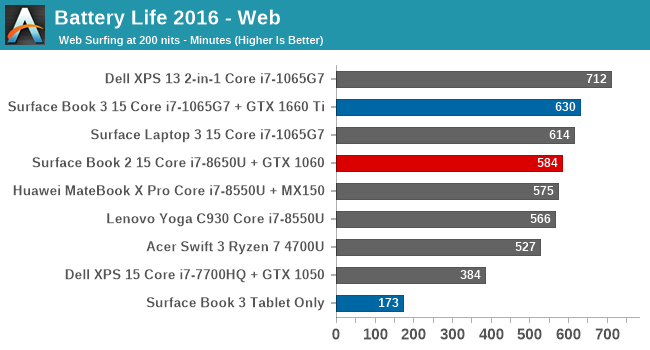
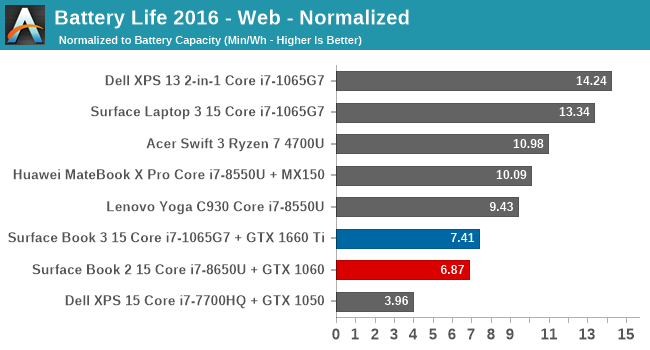
The extra battery capacity certainly helps the Surface Book 3 maintain all-day battery life. Despite the large, high-resolution display, the Surface Book 3 offers particularly good battery life at 10.5 hours on this test. It achieved 46 minutes more runtime than the Surface Book 2, and since they both share the same display, likely points to the efficiency gains of the new Ice Lake processor under load. There are devices that can achieve longer battery life, but since so much of the power draw is the display, they tend to have much lower power 1920x1080 offerings.
Movie Playback
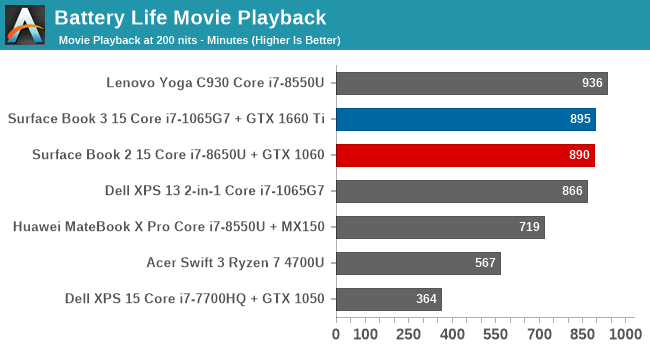
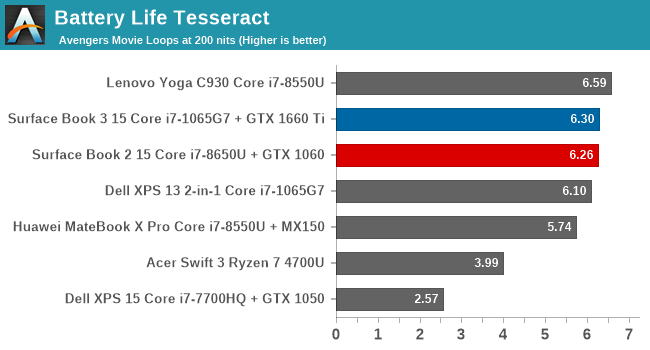
Movie playback tends to be one of the best ways to achieve battery life, since the video decode is offloaded to fixed-function hardware in the media block which can be very efficient. The Surface Book 3 achieves almost 15 hours of battery life in this test, outperforming the previous model by five minutes. Very impressive.
PCMark 10 Modern Office
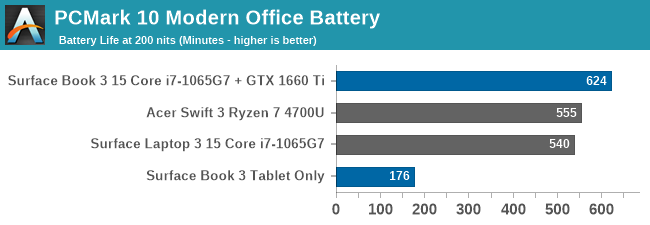
Adding in a new test means we unfortunately don’t have the backlog of data from previous devices, so for now please accept this smaller comparison. The large battery once again does what it intended, offering almost 10.5 hours here as well. The Modern Office battery test runs three scenarios, each at ten minutes in length. If a device finishes the test sooner, it will idle until the ten minutes is up, so faster devices will be able to get into the “hurry up and wait” stage which should be a benefit in this test.
Platform Power
The big 15-inch high-resolution display accounts for a big chunk of the Surface Book 3's power draw. With the display at the same 200 nits brightness we test at, measured power draw of the system was around 6.5 Watts, but with the display off, idle power draw dropped to as low as 650 mW, which is very impressive. Microsoft has certainly done their homework. That means the display accounts for almost six watts of draw at 200 nits. High DPI has its price, and that is battery life.
Also of note, the Surface Book 3 will disable the discrete GPU if the battery falls below a certain percentage, which seems to be around 8-10% charge. This was confirmed as by-design, and the NVIDIA GPU will no longer show up in device manager until the device is charged and rebootted.
Charge Time
Microsoft includes a 127-Watt AC adapter with the new Surface Book 3, which will prevent it from discharging under load like the previous model could, but as with most devices, the amount of power you put into the battery is never that high. If you need to charge the laptop on the go, it can also be charged over the USB-C connector, although you won’t achieve the power provided by the included adapter.

Interestingly, with the batteries split into two sections, you would think Microsoft would be able to charge the Surface Book quicker than most other devices, but they are pretty conservative with the power going back into the battery, likely to increase battery longevity. As such, charging from empty still takes over 2.5 hours.










125 Comments
View All Comments
zepi - Thursday, June 4, 2020 - link
How was batterylife in tablet mode without the base?Brett Howse - Friday, June 5, 2020 - link
Sorry I had tested that but forgot to add it to the graphs. It's there now.Wrong_again - Thursday, June 4, 2020 - link
It seems like an unpopular opinion but tablet devices should not have tiny bezels. For reasons that seem obvious to me.Retycint - Thursday, June 4, 2020 - link
The iPad Pro manages to have smaller bezels while not significantly affecting the usability. Smaller bezels does not necessarily mean tiny bezelss.yu - Thursday, June 4, 2020 - link
There's clearly a gap between this and "tiny". Also, again, the XPS 13 2N1 has a perfectly functional screen with arguably "tiny" bezels.PeachNCream - Thursday, June 4, 2020 - link
Tablets aren't really even a thing anymore. Hardly any company makes a credible attempt at producing one outside of the usual iFruits and Microsoft (I guess Google has Chrome-based hardware too if you like giving your personal information to the creepiest company on the planet). There are still a few 2-in-1 systems around and ultra low budget Android devices, plus a couple of laptops with questionably glossy touchscreens for reasons only the OEM can fully understand, but in general terms, tablets - Windows ones moreso than others - have been taken out back and shot, then tossed into a shallow grave with a bunch of other tech fads that failed to take enduring root.It is unexpected to watch Microsoft continue to release new models in a form factor that is laying in the desert, gasping its last parched air before failing to pull a Clint Eastwood-style survival montage. They already transitioned partly to clamshell designs to hedge the Surface brand name. It really is odd to see them clinging to the touch-everywhere bad old days of Windows 8.
lazybum131 - Thursday, June 4, 2020 - link
"It really is odd to see them clinging to the touch-everywhere bad old days of Windows 8."If only Microsoft actually did, then the tablet experience with Win 10 wouldn't be so poor. On Windows pure and detachable tablets aren't strong because the tablet experience just isn't good or polished even for built-in basic functions, let alone the barren app Store. Add in the slow progress on low-tdp chips that would actually enable portable designs.
lmcd - Thursday, June 4, 2020 - link
Intel's Lakefield could change the story there -- aside from the Intel tax with the experimental-technology surcharge, it could fit in 8 inch tablets. Based on the Surface Neo delay, I'd assume it's using a Lakefield chip.Microsoft's lack of good tablet software in the store boils down to the .NET team absolutely ignoring everything the Windows team would prioritize. Windows 10X doubles down on UWP while the .NET team hasn't released an up-to-date AOT compiler and C# project format in over 2 years.
Deicidium369 - Friday, June 5, 2020 - link
I will probably use the tablet mode on the 13 2-in-1 about as much as on the previous model - not much at all - but when needed (stocking up at a Spec's type place for a party) it is very useful. But yeah the time of the tablets looks to be over.Deicidium369 - Friday, June 5, 2020 - link
would be obvious 1st time it got dropped...